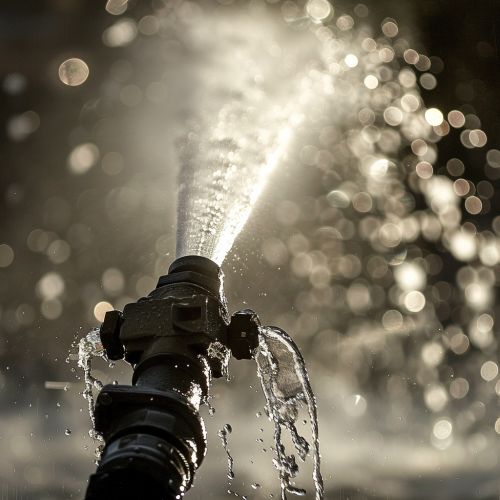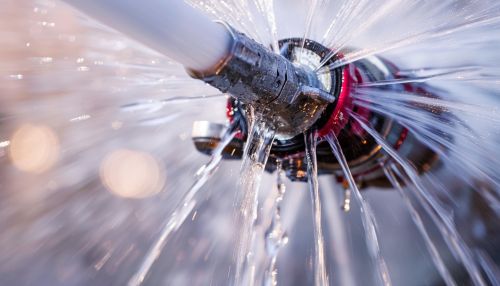Fire suppression: Difference between revisions
(Created page with "== Introduction == Fire suppression refers to the various methods and systems used to extinguish or control fires. It encompasses a wide range of techniques, technologies, and strategies designed to prevent the spread of fire, protect lives, and minimize property damage. Fire suppression systems are critical components in both residential and commercial buildings, as well as in industrial settings and public infrastructure. == History of Fire Suppression == The history...") |
No edit summary |
||
| Line 14: | Line 14: | ||
Fire sprinkler systems are automated systems that activate when a fire is detected. They consist of a network of pipes filled with water and sprinkler heads that release water when the ambient temperature reaches a certain threshold. There are several types of sprinkler systems, including wet pipe, dry pipe, pre-action, and deluge systems. | Fire sprinkler systems are automated systems that activate when a fire is detected. They consist of a network of pipes filled with water and sprinkler heads that release water when the ambient temperature reaches a certain threshold. There are several types of sprinkler systems, including wet pipe, dry pipe, pre-action, and deluge systems. | ||
[[Image:Detail-93321.jpg|thumb|center|Fire sprinkler system in action, spraying water.|class=only_on_mobile]] | |||
[[Image:Detail-93322.jpg|thumb|center|Fire sprinkler system in action, spraying water.|class=only_on_desktop]] | |||
==== Standpipe Systems ==== | ==== Standpipe Systems ==== | ||
Standpipe systems are a series of pipes and hoses installed in buildings, providing firefighters with a ready supply of water. These systems are particularly useful in high-rise buildings where it may be difficult to transport water to upper floors. | Standpipe systems are a series of pipes and hoses installed in buildings, providing firefighters with a ready supply of water. These systems are particularly useful in high-rise buildings where it may be difficult to transport water to upper floors. | ||
Latest revision as of 09:21, 22 June 2024
Introduction
Fire suppression refers to the various methods and systems used to extinguish or control fires. It encompasses a wide range of techniques, technologies, and strategies designed to prevent the spread of fire, protect lives, and minimize property damage. Fire suppression systems are critical components in both residential and commercial buildings, as well as in industrial settings and public infrastructure.
History of Fire Suppression
The history of fire suppression dates back to ancient civilizations, where rudimentary methods such as buckets of water and sand were used to combat fires. The development of more sophisticated fire suppression techniques began with the advent of organized firefighting brigades in ancient Rome. The Great Fire of London in 1666 spurred significant advancements in fire suppression technology, leading to the creation of the first fire insurance companies and the development of early fire engines.
Types of Fire Suppression Systems
Fire suppression systems can be broadly categorized into several types, each with its own unique mechanisms and applications.
Water-Based Systems
Water-based fire suppression systems are the most common and include fire sprinkler systems, standpipe systems, and fire hydrants. These systems use water to extinguish fires by cooling the burning material and reducing the temperature below the ignition point.
Fire Sprinkler Systems
Fire sprinkler systems are automated systems that activate when a fire is detected. They consist of a network of pipes filled with water and sprinkler heads that release water when the ambient temperature reaches a certain threshold. There are several types of sprinkler systems, including wet pipe, dry pipe, pre-action, and deluge systems.


Standpipe Systems
Standpipe systems are a series of pipes and hoses installed in buildings, providing firefighters with a ready supply of water. These systems are particularly useful in high-rise buildings where it may be difficult to transport water to upper floors.
Fire Hydrants
Fire hydrants are external sources of water that firefighters can connect to their hoses. They are typically found on streets and in public areas, providing a crucial water supply for firefighting efforts.
Chemical-Based Systems
Chemical-based fire suppression systems use various chemicals to extinguish fires. These systems are often used in environments where water-based systems may not be effective or could cause additional damage.
Foam Suppression Systems
Foam suppression systems use a mixture of water, foam concentrate, and air to create a foam blanket that smothers the fire, cutting off the oxygen supply. These systems are commonly used in areas with flammable liquids, such as fuel storage facilities and aircraft hangars.
Clean Agent Systems
Clean agent systems use gaseous agents, such as halon, FM-200, and Novec 1230, to extinguish fires. These agents are non-conductive and leave no residue, making them ideal for protecting sensitive electronic equipment and data centers.
Dry Chemical Systems
Dry chemical systems use powdered chemicals, such as monoammonium phosphate, to extinguish fires. These systems are effective against a wide range of fire types, including Class A, B, and C fires.
Gaseous Fire Suppression Systems
Gaseous fire suppression systems use inert gases or chemical agents to extinguish fires. These systems are often used in enclosed spaces where water or foam could cause damage.
Inert Gas Systems
Inert gas systems use gases such as nitrogen, argon, and carbon dioxide to displace oxygen and suppress fires. These systems are effective in protecting valuable assets and are commonly used in museums, archives, and server rooms.
Carbon Dioxide Systems
Carbon dioxide (CO2) systems use CO2 gas to extinguish fires by reducing the oxygen concentration to a level that cannot support combustion. These systems are highly effective but can pose a risk to human health if not properly managed.
Fire Suppression Techniques
In addition to fixed fire suppression systems, various techniques are employed by firefighters and emergency responders to control and extinguish fires.
Fire Extinguishers
Fire extinguishers are portable devices that discharge a fire-suppressing agent. They are classified based on the type of fire they are designed to combat, including Class A (ordinary combustibles), Class B (flammable liquids), Class C (electrical equipment), Class D (flammable metals), and Class K (cooking oils and fats).
Fire Breaks
Fire breaks are gaps in vegetation or other combustible materials that act as barriers to slow or stop the spread of wildfires. These breaks can be natural, such as rivers and roads, or man-made, such as cleared strips of land.
Controlled Burns
Controlled burns, also known as prescribed burns, are intentionally set fires used to manage vegetation and reduce the risk of larger, uncontrolled wildfires. These burns are carefully planned and executed to minimize the risk to people and property.
Fire Suppression in Different Environments
Fire suppression strategies and systems vary depending on the environment in which they are used.
Residential Buildings
In residential buildings, fire suppression systems are designed to protect occupants and property. Common systems include smoke alarms, fire sprinklers, and portable fire extinguishers. Building codes and regulations often mandate the installation of these systems in new constructions.
Commercial Buildings
Commercial buildings, such as offices, shopping centers, and hotels, require more comprehensive fire suppression systems due to the higher occupancy and potential for significant property damage. These systems may include advanced sprinkler systems, fire alarms, and emergency lighting.
Industrial Facilities
Industrial facilities, such as factories and warehouses, pose unique fire risks due to the presence of flammable materials and complex machinery. Fire suppression systems in these environments often include specialized systems, such as foam suppression and dry chemical systems, as well as robust fire detection and alarm systems.
Transportation
Fire suppression in transportation settings, such as airplanes, ships, and trains, involves specialized systems designed to protect passengers and cargo. These systems may include clean agent systems, foam systems, and portable fire extinguishers.
Fire Suppression Standards and Regulations
Fire suppression systems and practices are governed by various standards and regulations to ensure their effectiveness and safety.
National Fire Protection Association (NFPA)
The National Fire Protection Association (NFPA) is a global organization that develops and publishes codes and standards for fire safety. Key NFPA standards related to fire suppression include NFPA 13 (Standard for the Installation of Sprinkler Systems), NFPA 72 (National Fire Alarm and Signaling Code), and NFPA 2001 (Standard on Clean Agent Fire Extinguishing Systems).
International Building Code (IBC)
The International Building Code (IBC) is a model building code developed by the International Code Council (ICC). It provides guidelines for the design and construction of buildings, including requirements for fire suppression systems.
Occupational Safety and Health Administration (OSHA)
The Occupational Safety and Health Administration (OSHA) sets regulations for workplace safety, including requirements for fire suppression systems in industrial and commercial settings. OSHA standards ensure that fire suppression systems are properly maintained and that employees are trained in their use.
Advances in Fire Suppression Technology
Recent advancements in fire suppression technology have led to the development of more effective and efficient systems.
Water Mist Systems
Water mist systems use fine water droplets to extinguish fires. These droplets have a larger surface area compared to traditional sprinkler systems, allowing for more efficient heat absorption and cooling. Water mist systems are particularly effective in enclosed spaces and areas with sensitive equipment.
Hybrid Systems
Hybrid fire suppression systems combine multiple suppression agents, such as water and foam or water and inert gases, to provide enhanced fire protection. These systems are designed to address the limitations of single-agent systems and offer greater flexibility in various fire scenarios.
Smart Fire Suppression Systems
Smart fire suppression systems use advanced sensors and control algorithms to detect and respond to fires more quickly and accurately. These systems can integrate with building management systems and provide real-time data to emergency responders, improving overall fire safety.
Challenges and Considerations
Implementing fire suppression systems involves several challenges and considerations.
Cost
The cost of installing and maintaining fire suppression systems can be significant. Building owners and managers must balance the need for effective fire protection with budget constraints.
Maintenance
Regular maintenance is crucial to ensure the reliability and effectiveness of fire suppression systems. This includes routine inspections, testing, and servicing of components.
Environmental Impact
Some fire suppression agents, such as halon, have been found to have negative environmental impacts, including ozone depletion. As a result, there has been a shift towards more environmentally friendly agents, such as FM-200 and Novec 1230.
Human Safety
Certain fire suppression systems, such as CO2 systems, can pose risks to human health if not properly managed. It is essential to design and operate these systems with safety considerations in mind.
Conclusion
Fire suppression is a critical aspect of fire safety, encompassing a wide range of systems and techniques designed to protect lives and property. From water-based systems to advanced clean agent technologies, fire suppression continues to evolve, driven by advancements in technology and a growing understanding of fire dynamics. Effective fire suppression requires careful planning, regular maintenance, and adherence to established standards and regulations.
